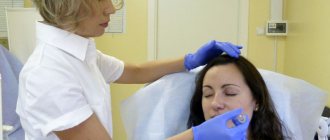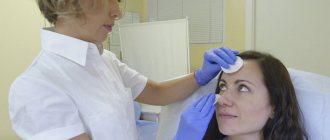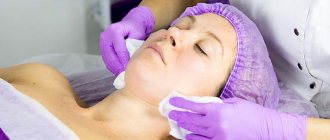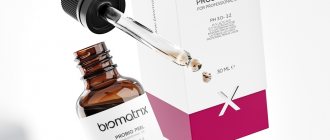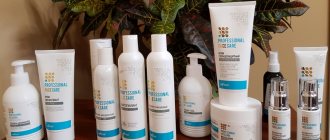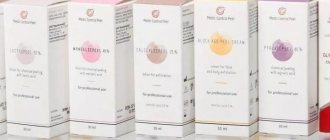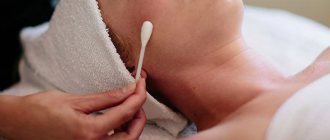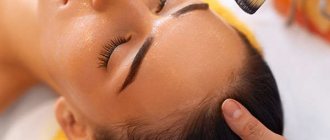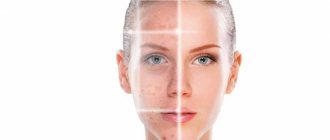Our skin is very susceptible to external factors. The basis of a healthy skin condition is self-healing, regeneration of new cells. Actually, peeling is a method based on the principle of skin reproduction. The older a person is, the worse the skin reproduces dead cells. And without the regeneration of collagen and elastin, which are responsible for skin firmness, skin rejuvenation is unthinkable.
Facial peeling is designed to restore impaired skin regeneration, thereby promoting its rejuvenation. The effect of the procedure cannot be reduced to one thing: this procedure can help solve a variety of skin problems: from wrinkles to scars.
There are three main types of peeling:
chemical, physical and mechanical.
The first type of peeling uses chemical solutions and compositions.
Physical peeling is based on the use of ultrasound pulses and laser.
Finally, mechanical peeling comes down to manual manipulation of the skin and the impact of special grinding devices on it.
By the way, peeling is different from peeling: depending on the purpose of the procedure, the depth of impact on the skin may be different. So, in some cases, you can get by with treating the outer layer of the skin and exfoliating it superficially. For more serious skin problems, on the contrary, deep peeling is required.
Benefits of chemical peeling for the face
In order to fully appreciate the advantages of chemical peeling, you should first of all understand that the technique is aimed at completely cleansing the surface layers of the skin from keratinized epidermal cells, excess sebaceous secretions and polluting agents . The essence of the procedure is to receive a controlled light chemical burn under the influence of an acid or enzyme composition, as a result of which the skin is cleansed and renewed, forming a young, healthy epidermal layer.
The effectiveness of chemical peeling lies in the following aesthetic and physiological effects:
- Skin cleansing . Under the influence of acid, a significant weakening of the intercellular connections of the stratum corneum occurs, which leads to the elimination of dead cellular structures. A similar reaction is observed in relation to sebum and the contents of the epidermal ducts. As a result, the skin is cleansed of excess surface elements, acquiring an even structure and a healthy color tone.
- Rejuvenation . The anti-age effect that can be achieved by chemical peeling is due to the complete renewal of the surface layers of the epidermis. After the chemical destruction of dead skin cells, an active regeneration process is launched, which leads to the formation of new, young skin cells. In addition, the activation of internal growth factors provokes the production of collagen and elastin by cellular fibrils, which results in increased elasticity and firmness of the skin, as well as smoothing of epidermal facial wrinkles and skin creases.
- Normalization of the sebaceous glands . Cosmetologists especially often recommend peeling procedures to patients with oily skin. This is explained not only by the ability to clear clogged gland ducts from natural secretions, but also by the effect of optimizing the functioning of the sebaceous glands and narrowing the skin channels. A full course of peeling procedures significantly reduces the oiliness of the epidermis and eliminates the manifestations of acne and acne, restoring the natural beauty of the facial skin.
- Elimination of skin defects . Chemical peeling is often used as a therapeutic technique for eliminating scars, scars, especially those formed as a result of acne, as well as age spots. The last aspect is based on the fact that the melanin pigment is produced in the superficial skin structures, which are quickly renewed under the influence of peeling.
Considering the relationship between the pros and cons of chemical peeling, we can clearly draw conclusions in favor of this cosmetic procedure, since it is almost impossible to achieve the appropriate aesthetic effects without the use of chemical agents.
There are several functional types of peelings:
One of the most effective, but also the most “aggressive” methods is laser peeling. The effect of the laser is truly amazing. Many are even inclined to believe that there is no problem that cannot be solved with the help of a laser.
Chemical peeling can be considered the safest. This method may be considered gentle, but this does not mean that it is not effective. The choice of one type of procedure or another depends on the characteristics of the individual patient. Thus, chemical peeling is recommended for patients with thin skin that is highly sensitive. And also after it there are almost no restrictions associated with the recovery period.
In most cases, chemical peeling is sufficient to solve all skin problems. In this case, it is necessary to perform from 3 to 6 sessions.
It is worth remembering that any type of peeling has a fairly strong effect on the skin. That’s why she needs time to recover. So do not overdo it with the frequency of procedures. And of course, such a complex procedure can only be trusted to qualified cosmetologists and should not be repeated at home.
How is peeling performed and what should you pay attention to after the procedure?
Before the procedure, the skin is cleansed and “degreased”. During the procedure, you will feel warmth and burning on the treated skin surface. To reduce discomfort, you can use a fan or local anesthetic. After peeling, first of all, take care of protecting your skin from the sun, so it is not recommended to carry out the procedure at the height of summer or before leaving for warm countries.
After peeling, you will feel tightness and slight dryness of the skin. The skin may remain red for an hour after the procedure. The condition of the skin in the post-peeling period depends on the type of skin and the type of peeling performed.
It is recommended to avoid excessive physical activity and excessive sweating for several days after the procedure. Do not rub the treated skin area after peeling. Do not use retinol or AXA products for at least 10 days after peeling. Avoid visiting the sauna or bathhouse for several days.
What can be dangerous about peeling in summer?
Peeling is a cosmetic procedure that helps remove dead dead skin cells with accumulated dust particles and bacteria.
Effect after manipulation:
- acne prevention;
- cleansing all layers of skin;
- lifting;
- skin smoothing and scar treatment;
- improving the permeability of caring components of cosmetics.
There is another side to the coin: skin regeneration does not occur instantly; the delicate top layer can easily dry out. If you sunbathe after the procedure, know that the tan will be patchy and you will have to work hard to even it out.
Many women ask the question: “Can I peel in the summer if I don’t sunbathe?” However, on the eve of the velvet season, one should not forget about photoaging - changes in the condition of the skin under the influence of sunlight. The middle and deep layers of the skin are sensitive to ultraviolet radiation. By removing the top layer, you leave them unprotected.
The weather is warm outside and you can't wait to sunbathe? You'll have to wait to visit the salon. Avoid deep peels, beauty injections and laser treatments in favor of youth. Popular renewal products contain components that can enhance the effects of the sun on the skin. If you live in the south, where summer extends far beyond its calendar period, this means that the dermis will have to be protected longer.
Is it possible to do peelings in the summer? This question is often asked by women with oily or problematic skin. The sun activates the sebaceous glands, and the procedure can alleviate the condition of the dermis. Some people use peeling to lighten scars and blemishes that cover the skin unsightly. However, the fight against them is long and does not always bring success. If you decide to do summer peeling, adhere to the following rules:
- Remove only the old stratum corneum without damaging the dermis.
- After the procedure, use sunscreen.
- Buy a hat with a wide brim. Thanks to it, you will not be exposed to direct sunlight, and an elegant accessory will make your look truly summer.
Hyperpigmentation may not occur naturally, but can be a complication after peelings, which occurs quite often. But this result cannot be compared with the consequences of photoaging, or helioderma. Most people living in Israel and California have dark, pigmented skin. The reason for this is the active sun, so they do not think about complications and do not wonder whether peeling can be done in summer and spring.
Modern cosmetology is an evolving system that annually offers new technologies and procedures that help women look more attractive. Over time, “horror stories” about the dangers of summer peelings cease to be relevant. The compositions of the products are becoming more gentle and are recommended for regular comprehensive care. Summer peeling gently cleanses pores, enriching the skin with oxygen and removing toxins. The procedure is included in comprehensive care. The tan lies evenly on the smooth, renewed dermis and looks attractive.
Therefore, in the summer you need to do gentle peelings that are gentle on the skin. Their task will be to cleanse and reduce sensitivity to ultraviolet rays.
Cosmetologists recommend resorting to peelings if:
- acne-prone skin;
- tissues are subject to rapid scarring and fresh marks need to be treated;
- the dermis is peeling or has become flabby;
- complexion is gray and uneven.
If your skin is fair, you do not tan, but turn red, and are forced to constantly use sunscreen, this is not a reason to refuse peeling in the summer. Tell your cosmetologist about the characteristics of your dermis, and he will select a special composition for you.
Peeling in summer is prohibited in the following cases:
- you are allergic to medications or have sensitive skin;
- you are sick;
- hormonal imbalance;
- you are pregnant or breastfeeding (in such cases, the skin reaction cannot be predicted).
Take these contraindications into account and remember that the effectiveness of the procedure and the speed of skin restoration depend on the general condition of the body.
If you are a fan of a tanned body, sunbathe before the cosmetologist's office, then wait 8-10 days and go for a cleanse. The procedure will take place without complications, will be useful and will cause only positive emotions.
If you have made a conscious decision to exfoliate in the summer, remember: your doctor has the final say. You should not be offended or angry if the manipulation is refused, because the specialist knows better than you whether you should conduct a session now or whether it is wiser to wait for the right moment. Don't risk your skin.
Read material on the topic: Salicylic peeling: healing, rejuvenating, cleansing
Disadvantages of this procedure
Since exposure to acids on the skin is an aggressive process, this technique has disadvantages:
- a large list of contraindications;
- painful sensations due to chemical burns of the skin;
- long rehabilitation period - for superficial and medium penetration of acids is 10 - 14 days, for deep penetration - up to 2 months;
- possible appearance of hyper- or hypopigmentation - dark or light areas on the skin;
- Usually one procedure is not enough - treatment and rejuvenation must be carried out over a course;
- acids can cause allergies, even if there were no complaints of a reaction before the procedure.
After the session, you should not sunbathe for a long time under the sun or in a solarium, since ultraviolet radiation can cause complications. Therefore, acid exfoliation is not recommended in the summer; it is better in the cold season.
What problems does peeling solve?
As a rule, exfoliation is recommended for aged (after 35 years) and problem skin. The main indications for prescribing peelings include:
- dry, dull, aging skin
- long-term inflammatory skin diseases, such as acne and acne, which are characterized by the formation of pustules (pustules), comedones (blackheads) and, as a result, scars
— wrinkles (age-related, expression lines)
— premature age-related changes in the skin due to exposure to ultraviolet rays (photoaging)
– pigmentation (dark spots and freckles)
- scars, cicatrices, loss of clarity of the oval of the face
